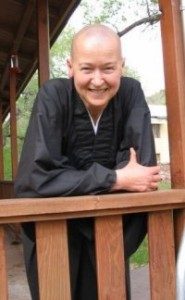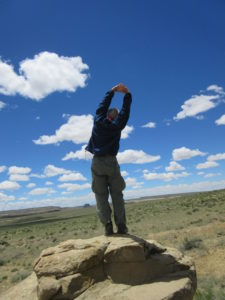|
|

|
|
What a difference a day and a night can make!

Come join Earth Walks for a restorative and energizing overnight journey with the earth, sky, water and spirit at Bodhi Manda Zen Center, Jemez Spring New Mexico. You are invited to help co-create an alchemical experience with whatever you wish to bring—music, movement, outstanding jokes or simply your presence.
While not a meditation retreat, participants will be welcome to join Abbess Hosen and Bodhi community members in early morning meditations. Here’s a sample of what some of those attending are offering as possible elements to this magical Solstice brew—all optional:
Here’s a sample of what some of those attending are offering as possible elements to this magical Solstice brew—all optional:
Most importantly, there will be time for quiet reflection. Hot springs along the Jemez River at Bodhi beckon to participants night and day. If you need time alone at the gathering, you are warmly encouraged to do so whenever the spirit moves. Balance is the theme for this Solstice retreat.
Plans: Departure from Santa Fe at 9 a.m., Friday June 21, 2019. Travel by carpool. Return, following the noon meal, Saturday, June 22. Participants are welcome to linger longer and stay another night if they wish. Cost: Only $110 per night (includes lodging and four delicious meals).
Registration: Due by June 14. Contact Earth Walks earthwalks1@yahoo.com (A limited number of private rooms may be available at slightly higher cost.)
Helping clear the fields and gardens
EARTH WALKS TO JEMEZ PUEBLO, NEW MEXICO June 20-22, 2019
Join hearts and hands at Jemez Pueblo with the Flower Hill Institute farm, tending the land, planting heritage seeds and experiencing traditional cultural values, sponsored by Earth Walks of Santa Fe, New Mexico. We will be joined by the summer Pueblo youth camp, elders and other community members.
Roger Fragua, director of the Institute farm said, “Farming with nature (the root of organic farming) lies at the heart of practices used by native farmers in the Southwest for millennia. Traditional cultural farming can teach us a great deal about how to build a resilient and regenerative agriculture.” A children’s butterfly pollination dance will celebrate the fields.
A special part of the gathering will be with Abbess Hosen guiding the group in the practice of mindfulness in action as we assist in the beautiful organic gardens at the Zen Center. Meditations in the zendo are an option as well. Lodging is dormitory style at Bodhi Manda Zen Center where there are relaxing hot springs alongside the Jemez River. 
Cost: $375 (two nights lodging and meals) A limited number of private rooms are available at additional cost. Volunteer for one both days only at no cost except for meals.
Registration/information: info@earthwalks.org
Join hearts and hands at Jemez Pueblo with the Flower Hill Institute farm, tending the land, planting heritage seeds and learning about traditional cultural values. We will gather with the summer Pueblo youth camp, elders and other community members. Roger Fragua, director of the Institute farm said, “Farming with nature (the root of organic farming) lies at the heart of practices used by native farmers in the Southwest for millennia. Traditional cultural farming can teach us a great deal about how to build a resilient and regenerative agriculture.” A wonderful children’s butterfly pollination dance will celebrate our work in the fields.
A special part of the retreat will be with Abbess Hosen guiding the group in the practice of mindfulness in action as we assist in the beautiful organic gardens at the Zen Center. Meditations in the zendo are an option as well. Lodging is dormitory style at Bodhi Manda Zen Center where there are relaxing hot springs alongside the Jemez River. A limited number of private rooms are available at additional cost.
Here’s a great local program, Tewa Women United, who made it into Vogue Magazine with their Tewa Birthing Project. They are involved in a lot of helpful programs and Earth Walks volunteers have worked in their Healing Oasis Garden over the past several years. Here’s the link to the Vogue article: TWU Birthing Project

CHACO CANYON, NM JOURNEY–ONLY A FEW SPACES LEFT FOR THIS SPECIAL OPPORTUNITY! October 6-8, 2018
Come join the journey to Chaco Canyon October 6-8! It’s a holiday weekend…led by a family of Tesuque Pueblo who consider Chaco to be ancestral homeland. Time alone and time with a wonderful group of fellow travelers. All meals prepared for your at campsite…and all for a very affordable price. Registration deadline is September 6.
At an elevation of 6,200 feet, Chaco is a high desert, sun-scorched in the summer and bitterly cold in the winter. Despite these harsh conditions, evidence of human presence in the area stretches back to as early as 2900 BC. These groups were largely nomadic, until around AD 200, when the first farmers settled in the area and built small pit houses.
Then in roughly AD 850, a great change took place. The people began building in a radically different manner, constructing massive stone buildings unlike any that had been built before. These structures soared to four or five stories and contained up to seven hundred rooms and dozens of mostly circular underground ceremonial rooms.
The architecture was a feat of engineering, often built along celestial alignments, they included water-collection systems and were linked to outlying communities by an extensive network of roads. These elaborate buildings evidence a sophisticated and highly organized culture, with Chaco Canyon at its center.
Here’s more about the Earth Walks to Chaco Canyon, NM October 6-8, 2018:
What you can look forward to on the journey:
Transportation is by carpooling. Lodging is camping or camper truck/van. Participants responsible for own camping equipment. No RV.
Cost: $375 Includes guiding services, campsite fee, all meals. Does not include transportation to and from the Canyon, entrance fee per car ($25)
For more information and how to register, contact: earthwalks1@yahoo.com
EARTH WALKS TO CHACO CANYON—JOIN A WONDERFUL GROUP OF TRAVELERS TO THIS SPECIAL PLACE IN THE AMERICAN SOUTHWEST!
me join the journey to Chaco Canyon October 6-8! It’s a holiday weekend…led by a family of Tesuque Pueblo who consider Chaco to be ancestral homeland. Time alone and time with a wonderful group of fellow travelers. All meals prepared for your at campsite…and all for a very affordable price. Registration deadline is September 6.
At an elevation of 6,200 feet, Chaco is a high desert, sun-scorched in the summer and bitterly cold in the winter. Despite these harsh conditions, evidence of human presence in the area stretches back to as early as 2900 BC. These groups were largely nomadic, until around AD 200, when the first farmers settled in the area and built small pit houses.
en in roughly AD 850, a great change took place. The people began building in a radically different manner, constructing massive stone buildings unlike any that had been built before. These structures soared to four or five stories and contained up to seven hundred rooms and dozens of mostly circular underground ceremonial rooms.
The architecture was a feat of engineering, often built along celestial alignments, they included water-collection systems and were linked to outlying communities by an extensive network of roads. These elaborate buildings evidence a sophisticated and highly organized culture, with Chaco Canyon at its center.
Here’s more about the Earth Walks to Chaco Canyon, NM October 6-8, 2018:
What you can look forward to on the journey:
Transportation is by carpooling. Lodging is camping or camper truck/van. Participants responsible for own camping equipment. No RV.
Cost: $375 Includes guiding services, campsite fee, all meals. Does not include transportation to and from the Canyon, entrance fee per car ($25)
For more information and how to register, contact: earthwalks1@yahoo.com
(Join the Earth Walks program in a three day journey to Chaco Canyon October 6-8, 2018 camping under the stars, guided by a New Mexico Pueblo family who consider the site as their ancestral homeland. For information on cost and registration: https://earthwalks.org/ )
At an elevation of 6,200 feet, Chaco is a high desert, sun-scorched in the summer and bitterly cold in the winter. Despite these harsh conditions, evidence of human presence in the area stretches back to as early as 2900 BC. These groups were largely nomadic, until around AD 200, when the first farmers settled in the area and built small pit houses.
Then in roughly AD 850, a great change took place. The people began building in a radically different manner, constructing massive stone buildings unlike any that had been built before. These structures soared to four or five stories and contained up to seven hundred rooms and dozens of mostly circular underground ceremonial rooms.
The architecture was a feat of engineering, often built along celestial alignments, they included water-collection systems and were linked to outlying communities by an extensive network of roads. These elaborate buildings evidence a sophisticated and highly organized culture, with Chaco Canyon at its center.
The people of Chaco demonstrated extraordinary observations of astronomical phenomena which they incorporated into their buildings by designing, orienting and locating their major buildings in relationship to solar and lunar events. This required advanced architectural and design skills, scientific observation and social cohesion. Some think the civilization that flourished here parallels that of Aztec, Mayan and Inca cultures.
This autumn, join a journey into the vast silence and wonder of Chaco Canyon National Historical Park. There is no accident that Chaco, located in northwestern New Mexico was designated a United Nations’ World Heritage site. Containing the most sweeping collection of ancient architecture north of Mexico, the park preserves one of the most important pre-Columbian cultural and historical areas in the United States. Chaco is remarkable for its monumental public and ceremonial buildings, some of which are unlike anything constructed before or since. Between CE 900 and 1150, Chaco Canyon was a major center of culture for the Ancient Pueblo peoples, and now we are invited to visit this special place guided by Pueblo people who consider Chaco their ancestral home.
Chaco itself offers the invitation. As one of the Park rangers has said Chaco video , for many people these are not empty buildings that express something from the past; to those who consider this site sacred, there is still life in these buildings and land.
Here’s what you can look forward to on the journey:
Earth Walkers in the Eyes of Pueblo Guide
Come Join Us!
Transportation is by carpooling. Lodging is camping or camper truck/van. Participants responsible for own camping equipment. No RV.
Cost: $375 Includes guiding services, campsite fee, all meals. Does not include transportation to and from the Canyon, entrance fee per car ($25)
For more information about the journey and how to register, contact: earthwalks1@yahoo.com
